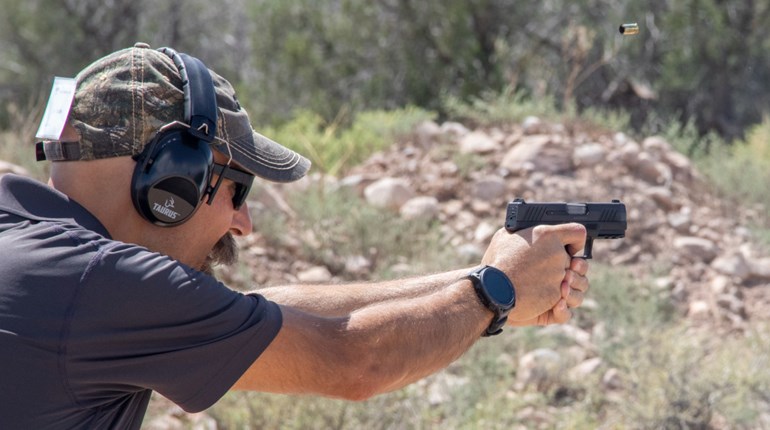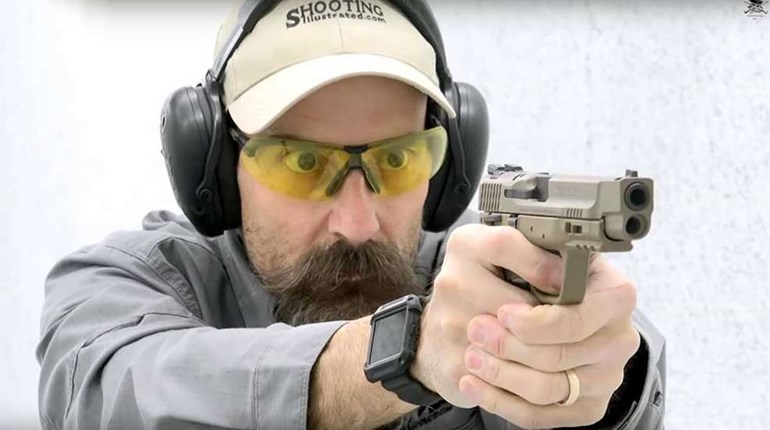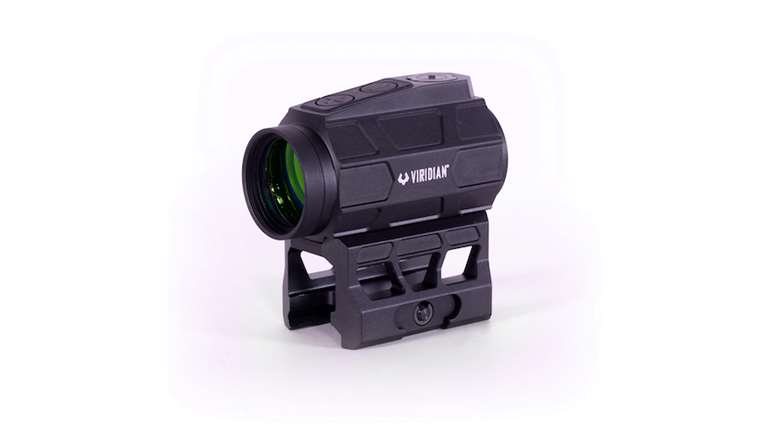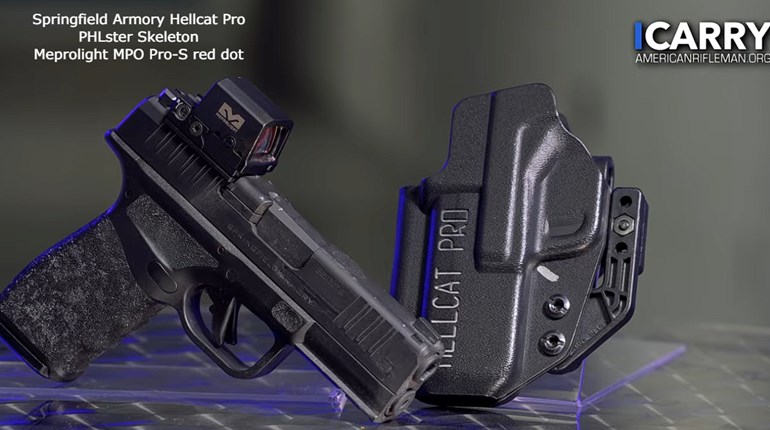
When things get ugly, the world can be divided into two types of people: the mentally prepared (who can rely on their mindset and their ability to make decisions under duress) and those who depend on Lady Luck, or her equally fickle stepsister, Lotsa Hope.
Your survival in any life-threatening altercation depends squarely on your mindset and the decisions you make when engaging a physical threat. Starting with situational awareness, if you don’t have the right mindset and are mentally unprepared to do what it takes to solve the problem, then you’re already behind the eight ball and have relegated your fate to luck and hope.
Thomas Jefferson said, “Nothing can stop the man with the right mental attitude from achieving his goal; nothing on earth can help the man with the wrong mental attitude.” The first step to managing any physical violence is to first be mentally prepared to engage that violence. Most people believe it won’t happen. “Hey, it’s never going to happen to me or anyone in my family.” A very close second viewpoint is “Well, if something happens, it’s not my problem—after all, isn’t that’s what we pay cops for?” Neither of the aforementioned perspectives will serve you best when the “stuff” hits the air-oscillation device.
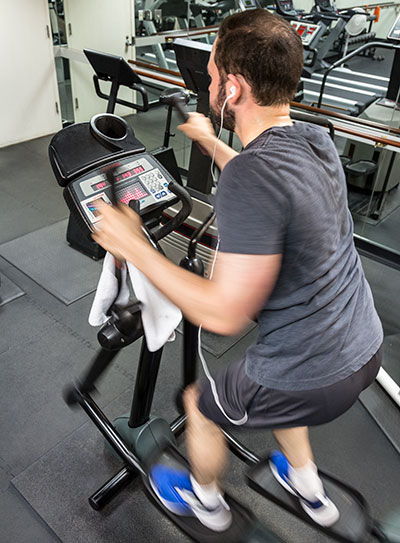
Preparation for threat engagement includes having the appropriate mindset going into it. If you truly believe that it can never happen to you or that if it does, someone else will solve the problem for you, then you suffer from a severe case of cranial-rectal inversion from which there is no recovery. Conversely, armed with the appropriate mindset that personal security is your responsibility, and being mindful of your surroundings (practicing good situational awareness), gives you sound mental footing to meet the challenge of an active threat.
Equally as important as appropriate mindset when the threat appears, you may find yourself beset by slow decision-making. Being confronted by an active shooter, a truck driving straight toward you on a sidewalk, an attacker trying to chop your head off with a machete, or someone attempting to dump acid on your face, may cause a significant delay in the time it takes for you to respond.
How we work as humans, in terms of physical response is to first intake sensory information such as visual (seeing an active shooter), auditory (hearing gunshots or screeching tires), olfactory (smelling smoke or something burning) and tactile (feeling a percussion blast or fire). We then interpret that data input, try to make sense of it by identification or recognition and then formulate a decision based on that understanding. All of this must occur before we can implement that decision via movement.
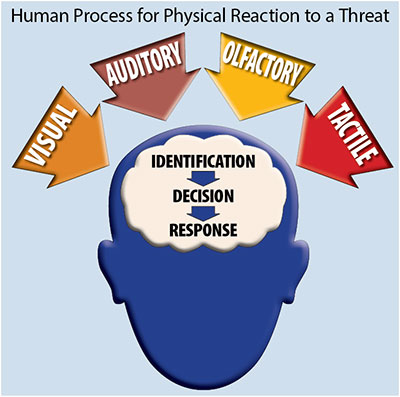
The entire decision-making process takes a subjective yet measurable amount of time, which, in turn, slows down your response actions. Why? We need relevant information to act. We need to have enough useful information to help us solve the tactical problem. We must process incoming, real-time data so we can arrive at what we believe to be an appropriate decision based on that information. Without that decision, there can be no physical implementation. The more time we spend spinning our proverbial wheels formulating a decision, the more time it takes to respond to the threat. Therefore, the longer you sit motionless in danger, the greater your potential for personal injury.
In non-threatening circumstances, the amount of time between data input and physical response can also be measured. The complexity of the task can increase the time. However, under duress, that lag time can double or, depending on the severity of the situation, cause a complete vapor lock.
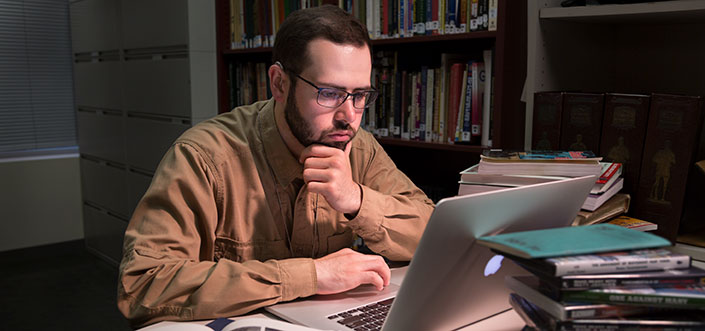
In his book “Nerve, Poise Under Pressure, Serenity Under Stress and the Brave new Science of Fear and Cool,”1 authorTaylor Clark writes:
“In the 1970s psychologist Daniel Johnson found that when he asked subjects to perform a challenging and novel task under pressure, 45 percent of them shut down and stopped moving for a minimum of 30 seconds.”
What exactly is it that gums up your brainbox wheel-housing, especially in high-stress situations like confronting an active threat? It’s the type of information received by your senses. That information can become a mental logjam if it’s something you’ve never experienced before (new), completely foreign to you in your day to day (unfamiliar) and scares the stuffing out of you (threatening).
If you’re familiar with automobiles and you see a model or design you’ve never seen before, then that visual input registers as “new” to your computer. Although different than what you may be accustomed to, a car is not unfamiliar to you. However, it does take a second or two to process it because you’ve never seen that specific car before. But, at least you have prior knowledge of what a car is and, it’s not completely foreign to you. Nonetheless, it takes a bit of time to process because it’s new information.
Looking out your office window, you spot what appears to be a hybrid drone-car in the parking lot. Whatever that thing is, it can fly. It is neither a car nor an airplane, but some freakish mechanical invention that is completely unfamiliar to you. You may do a double-take, or study it for another second or two, to fully absorb what this foreign object may be all about. This takes a little more time to process because it’s something with which you’re utterly unfamiliar.
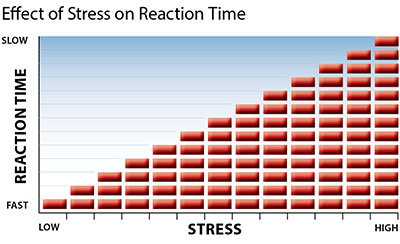
Should you find yourself up against the wall in a nasty situation, gun in your face or knife at your throat, where you feel threatened, this can elicit such emotions as abject fear and trepidation. An involuntary physical reaction to that emotion might be to take pause. As the incoming information is threatening, it may take more than a few seconds to collect yourself.
Any one of these three classifications of information—new, unfamiliar or threatening—can slow down the gears between your ears. Each one of them may cost you several seconds in processing time. Now, imagine your brain taking in information that falls under all three (new, unfamiliar and threatening) as in the case of your involvement a real-world active threat. An information overload like that could add as much as 30 seconds (or more) processing time to your circuitry. In a violent life-threatening physical altercation, you may well encounter one, two or even all three categories of input.
When caught in the pincers of an active threat, the longer it takes to process that information, the longer you are in danger. To solve the problem proactively is to prepare yourself to spend less time in harm’s way, which translates to less time calculating the tactical solution. How can you accomplish this? Cognitive visualization, physical activity
and training.
“Brain studies now reveal that thoughts produce the same mental instructions as actions. Mental imagery impacts many cognitive processes in the brain: motor control, attention, perception, planning, and memory. So, the brain is getting trained for actual performance during visualization. It’s been found that mental practices can enhance motivation, increase confidence and self-efficacy, improve motor performance, prime your brain for success, and increase states of flow.”2
Training or running drills and responses, even in thought (visualization), pre-loads information in your conscious and subconscious mind.3 It creates a familiarity, so the process is no longer complex and cumbersome, which frees your mind from paralysis and allows you to act.
If you’ve ever been in a nail-biting physical altercation, you understand the physiological effects of such an event. To develop a resistance to these effects, you may want to take up some form of physical training such as cardio exercise to increase your heart rate as well as the flow of endorphins.
Get trained, even if it’s reading books, blogs or watching videos about managing threats and winning fights. At minimum, you will have some familiarization and cognitive visualization of similar information. The more familiar you become with the subject of self-defense (knife or gun training) the more desensitized and inoculated you become to the newness or unfamiliarity.

When you hear a funny joke for the first time, you laugh out loud. The second time you hear it, you just kind of chuckle. The third time a polite smile and anytime after that it has absolutely no effect. Similarly, to inoculate yourself from something threatening—the more you know about it the less it will adversely affect you. You become mentally desensitized to that effect.
The sound of screeching tires or the report of gunfire (if you’ve never been, go to a race track or a shooting range and listen to exactly what these events sound like) become more familiar and less threatening.
Seasoned shooters can observe this phenomenon when they watch a brand-new shooter who has never pressed a trigger and experience an explosion at the end of his/her firearm for the very first time. If they don’t drop the gun altogether, then they will at least be physically startled, or minimally blink or close their eyes.
After a full day training at the range, you will notice that same new shooter is less jumpy as he/she becomes more familiar with the firearm, desensitized to the explosive recoil and inoculated against the loud noise. The same applies to defensive training with weapons, such as knives. The more familiar you become with the most-common edged-weapon attacks and the defense against them, the more comfortable you become with your understanding, and the less impact an actual attack will have on you psychologically.
If incoming info is old news, familiar and not threatening, then your brain has experienced it before and there’s little or no adverse impact when processing that information. The brain says, “I have seen that before,” so now it can readily process that information allowing for the rapid interpretation and subsequent decision-making process based on that info and, decreasing your reaction time under stress.
When applied to an active threat, desensitizing yourself to new, unfamiliar and threatening becomes a homework assignment of familiarizing yourself with the most common components of any engaging a threat. You can research the internet for past incidents. There is no shortage of bad things that happen to good people. In the past decade, these undesired events have escalated.
You can read news stories, watch actual videos, look at pictures, use cognitive visualization or, even better, take an active-threat-defense training class to familiarize yourself with the drills, skills and expectations common to handling a real-world physical threat. Your desensitization efforts, should you ever find yourself in that situation, would pay dividends in return for the time invested.
Extreme violence is not something most humans are comfortable with from day one. Most folks are predominantly non-confrontational at the core and being subjected to overwhelming physical violence can send you into a cranial tailspin. The cause of that tailspin is the type of information that is input by the senses and delivered to the brain for processing—specifically new, unfamiliar and threatening information.
The remedy turns out to be converting information about an active threat from new to old, from unfamiliar to familiar, and from threatening to non-threatening. You owe it to yourself to take advantage of such desensitizing proactive measures.
1 Little, Brown and Company, 2011
2 Excerpt from the article “Seeing Is Believing: The Power of Visualization” by AJ Adams, MAPP https://www.psychologytoday.com/blog/flourish/200912/seeing-is-believing-the-power-visualization
3 International Journal of Mass Emergencies and Disasters, 1985, Human Response to Disasters
 Steve Tarani is a former CIA protective services subject-matter expert who served on Donald Trump’s pre-election protection detail. He is the lead instructor for the NRA’s Non-ballistic Weapons Training program, offered nationally to members. Tarani, an active protective agent, is a Central Intelligence Agency and FLETC-certified federal firearms instructor who also provides services for the U.S. Naval Special Operations Command, FBI National Citizens Academy Alumni Association, National Association of School Resource Officers (NASRO) and other government and private entities.
Steve Tarani is a former CIA protective services subject-matter expert who served on Donald Trump’s pre-election protection detail. He is the lead instructor for the NRA’s Non-ballistic Weapons Training program, offered nationally to members. Tarani, an active protective agent, is a Central Intelligence Agency and FLETC-certified federal firearms instructor who also provides services for the U.S. Naval Special Operations Command, FBI National Citizens Academy Alumni Association, National Association of School Resource Officers (NASRO) and other government and private entities.













